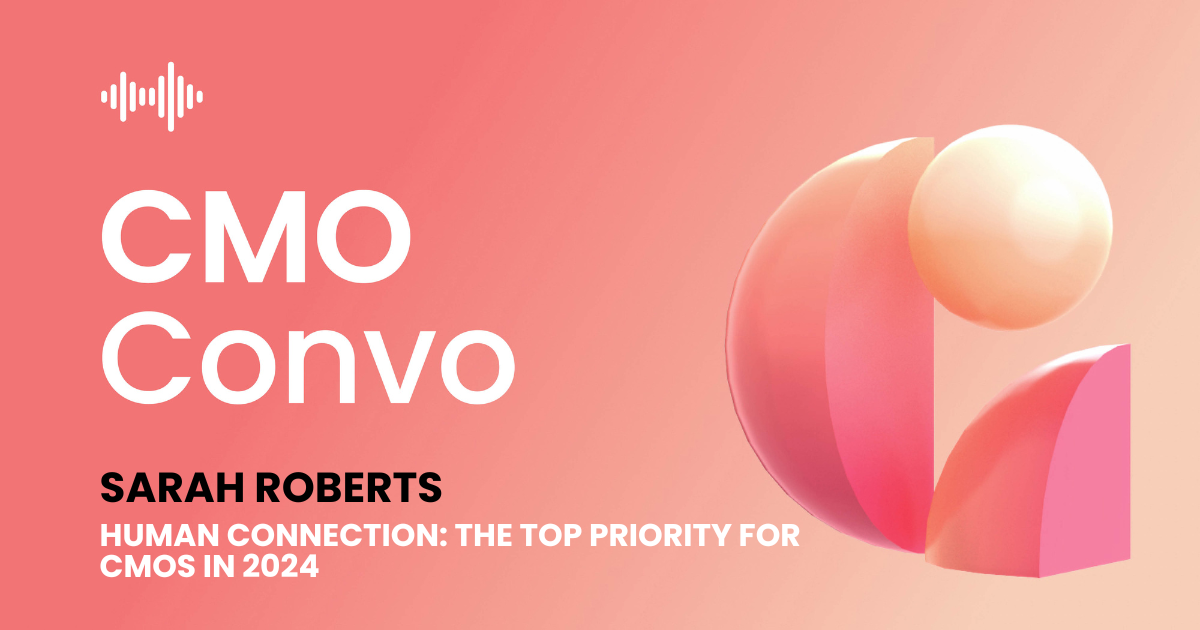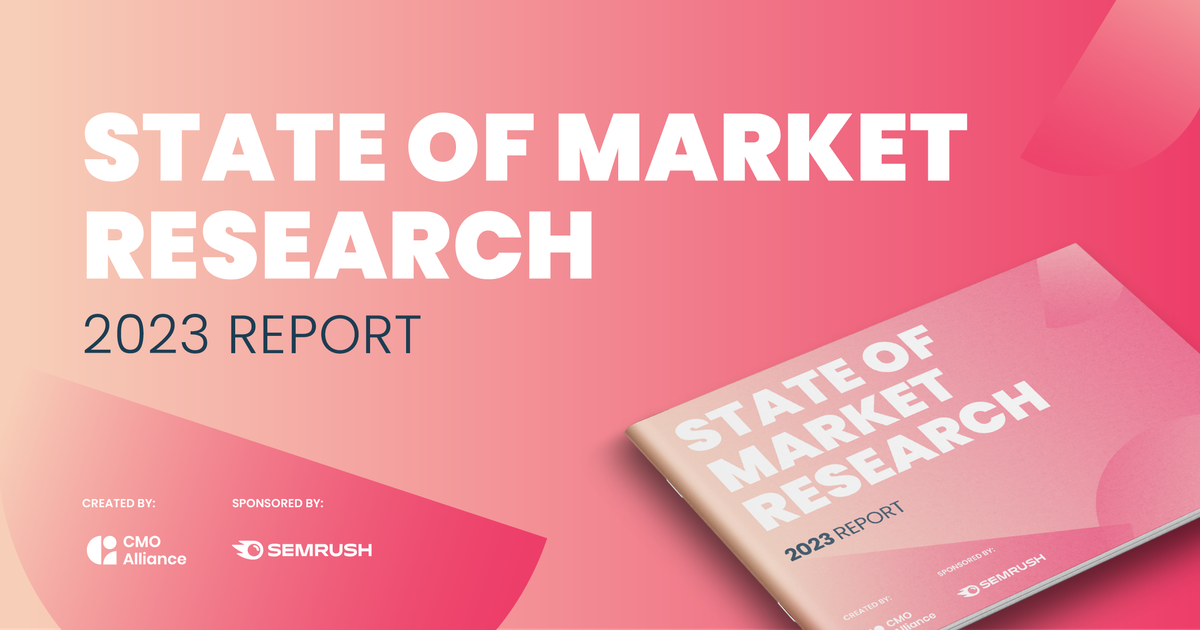This article was adapted from Miri's appearance on the CMO Convo Podcast.
Modern CMOs are constantly facing new marketing technologies, processes, and pressures. With all this going on, it can feel like there's no room for empathy.
In this article, I'll guide you on the journey of integrating empathy into your marketing practices. These insights and strategies aren't unique to Microsoft. They've propelled many other leading brands to greater customer engagement and brand loyalty.
Prefer to listen? Check out Miri's appearance on the CMO Convo podcast 👇
Defining empathy in a business context
Empathy, in a general sense, refers to the ability to sense, understand, and share the emotions of others.
When applying this in a business context, it's about comprehending the market landscape and recognizing where our customers' emotions. Understanding our customers' feelings within the current landscape is crucial.
It's not just about identifying if customers are happy or sad, but also understanding their frustrations and desires. This extends to various aspects, including their purchasing behaviors.
Consumer trends provide insight into emotional drivers behind purchases. It's a well-known concept that consumers make purchases based on emotion and then justify these decisions with logic.
However, we sometimes overlook that these trends are indicative of consumer behaviors. These behaviors drive the market, rather than the market driving these behaviors. Acknowledging this gap is vital.
Empathy as a skill in the digital transformation era
I initially believed empathy was merely a personality trait. That it's something you're born with, to different degrees. My perspective changed dramatically during the digital transformation at Microsoft. This transformation provided a raw, firsthand experience of the type of empathy required when creating content.
It took a personal journey: realizing that what I thought was relevant to my audience actually wasn't. I lacked the necessary empathy to initially understand them. This realization highlights the importance of introspection regarding our own levels of empathy. And you can apply the same principles across an organization.
Empathy is indeed a skill you can develop. An essential skill for genuinely connecting with customers and instilling a culture of empathy among employees.
Learning to be empathetic
My journey into empathetic storytelling began when I joined Microsoft's engineering organization, now known as Microsoft Digital. This was a newly established storytelling role as part of Microsoft's digital transformation.
I was tasked with uncovering stories within the AI and data verticals. We needed to focus on engineers transitioning to cloud engineering — a completely new domain for them and for Microsoft. Initially, I did not consider their individual frustrations, fears, or the personal transformations they were undergoing alongside the technological advancements.
I realized Microsoft's digital transformation was also a personal journey for each employee, including those in marketing roles. This transformation required an understanding and adaptation at a human level, not just operationally.
Despite my expertise, my initial efforts in content creation did not resonate as expected. It was a reflection that, perhaps, I wasn't truly understanding or empathizing with my audience.
I've been heavily inspired by Satya Nadella's reflections on empathy in his book ‘Hit Refresh’. It helped me recognize a gap in my approach — I wasn't genuinely empathetic towards my audience. Adopting a journalistic approach, I began to ask probing questions to understand their feelings, challenges, and motivations more deeply. This shift from assuming to understanding was pivotal.
The impact of empathetic storytelling
Utilizing design thinking, which starts with empathy as its first step, I transformed my strategy. This approach not only enhanced my connection with the audience. It also significantly improved the reach and impact of our content.
For example, an evergreen content site that previously averaged 125,000 views skyrocketed to 5 million views annually. Organically, without any advertising spend. This was a clear testament to the power of pausing to truly understand where your audience is at emotionally. You can then address their frustrations, fears, and needs with content that resonates with them at the right moment.
This experience taught me that empathy in business is about consistently striving to understand rather than solve right away. It involves a deep dive into the audience's current state. You need to re-evaluate strategies and content in real time to ensure they're still relevant and impactful.
Empathy isn't just a trait but a skill that can be honed. It requires a constant commitment to understanding both oneself and the audience to create truly meaningful connections and content.

Asking questions and listening for audience understanding
Learning to ask questions and truly listen to your audience is a pivotal moment in any marketer's journey. We often get wrapped up in the data and biases. Then we start to make assumptions and believe we know what's best for our customers.
However, the essential first step is to engage directly with customers. Ask them about their preferences for marketing and the type of content they find valuable.
Understanding how your audience consumes content is crucial. In my case, I found that my primary audience, engineers preferred reading content. They weren't keen on watching videos or engaging with trendy formats.
This insight challenged the prevailing notion that new and trendy formats are universally effective. Trends are fleeting and our audience's preferences may not align with them. That realization saved us from expending resources on content strategies that did not resonate.
We're witnessing what I term a "social media recession." People are overwhelmed by content and are beginning to pull back from social media platforms. Many people are favoring more traditional methods of communication like email.
This shift highlights the importance of staying attuned to how your customers are adapting to or rejecting these trends. You can gain valuable insights by using social media to listen, not just share content. This can help you understand what your audience likes and how they behave.
Truly understanding your audience requires a deep dive into their current behaviors, preferences, and the platforms they engage with. Empathy in this context means recognizing and adapting to these preferences. Ensure your marketing efforts align with what your audience wants and how they want to receive it.
Marketers must prioritize empathy and leveraging both direct engagement and social listening tools. You can better connect with customers, leading to more effective and impactful marketing strategies
Navigating rapid changes in platform preferences and content consumption
The digital landscape is in constant flux. New platforms are emerging and existing ones evolving or facing challenges that may affect user engagement. Understanding not only where your audience spends their time but also what they seek on those platforms is crucial.
For instance, the content expectations on Instagram differ vastly from those on Twitter, LinkedIn, or TikTok. Recognizing these nuances is key to tailoring your content strategy. You must meet your audience's needs in the context of each specific platform.
The advent of AI technology has revolutionized not just the channels of digital media. It's also introduced new tools and methodologies for creating and distributing content.
This disruption is significant in the marketing and communications space, prompting both consumers and creators to adapt. For marketers, especially at the CMO level, dedicating time to research and understand these shifts is becoming increasingly important.
While inclusivity remains a key trend, emphasizing relevance to your specific audience is paramount. It's essential to discern whether the content truly meets the needs and interests of your audience at the moment.
Marketers need to carefully evaluate if their content strategies match what their audience wants and likes. Focus on delivering value that is both pertinent and timely.
Leveraging AI for efficient content creation and strategic research
AI has significantly enhanced content creation processes, enabling faster and more efficient production of material. This technology allows marketers to refine their prompting techniques, producing relevant content swiftly.
AI is more than just speeding up content creation. It allows marketers to reallocate their time toward more in-depth research and cross-vertical conversations. ensuring the content they produce is not only relevant but also deeply resonant with their target audience.

Harnessing AI to enhance empathy in marketing
The introduction of AI and automation into marketing strategies might initially seem counterintuitive to fostering human connections. However, AI can significantly amplify our capacity for empathy. We can uncover insights and connections that would be beyond the scope of human analysis.
This advanced technology can analyze vast amounts of data in seconds. Offering precise, actionable insights that could take humans days to compile with the same degree of accuracy. If at all.
CMOs can use AI to test how content might be received in different regions of the world. For example, AI can differentiate between dialects and cultural references, ensuring content is appropriately tailored for its intended audience. This level of detail and predictive analysis allows for a more nuanced understanding of how messages will resonate, enhancing the empathy behind marketing campaigns.
By making it a practice to consult AI in the content creation and evaluation process — such as checking if a message is appropriate for a specific region or if the language used is accurately targeted — marketers can ensure their strategies are empathetically aligned with their audience's current context and needs.
Asking AI to review content before it's released can help identify potential misunderstandings or new perspectives that could make the content more relatable and impactful.
AI's ability to facilitate empathy in marketing is profound. It allows marketers to go beyond the surface level, enabling them to craft messages that resonate on a deeper, more personal level with their audiences.
As AI technology continues to evolve and learn from the data it's fed, its potential to support empathetic marketing strategies becomes even more significant. This approach not only enhances the effectiveness of marketing efforts but also ensures that they are rooted in a genuine understanding and consideration of the audience's feelings and circumstances.
The interplay between AI and empathy in marketing is not just about leveraging new technologies but about cultivating a deeper understanding of your audience. AI can be taught to "have empathy" by being prompted in ways that take into account the specific needs, problems, and business contexts of the target audience. This relationship-building with AI, through constant interaction, feedback, and refinement, can significantly enhance the relevance and impact of content.
The importance of research skills in modern marketing
As the digital landscape evolves, the skill of research becomes increasingly crucial for marketers, storytellers, and communicators. This skill is essential for navigating the complexities of new technologies like AI, ensuring content is not only created efficiently but also resonates deeply with the intended audience.
Effective research is vital in an era moving away from reliance on third-party data, urging marketers to develop a comprehensive understanding of their customers through first-party data and direct engagement.
Beyond generating empathy towards customers, it's essential to inspire your audience to empathize with your brand. This two-way empathy can transform how consumers perceive and interact with a brand, seeing it not just as a provider of products or services but as a relatable entity with its own identity, values, and story.
Brands that succeed in humanizing themselves and showing vulnerability in a balanced way can forge deeper connections with their audience, influencing consumer behavior more effectively than through product features alone.
The concept of vulnerability plays a critical role in humanizing brands, making them more relatable and trustworthy in the eyes of consumers. This approach was particularly evident during the pandemic, where brands that showed their human side, acknowledging mistakes, fears, and challenges, were able to strengthen their bond with consumers.
Sharing the "pitfalls and bruises" of experiences, as done in Microsoft's blog series on operationalizing the cloud, exemplifies how transparency and honesty can enhance brand loyalty and trust.
The journey towards embedding empathy into marketing strategies involves a multifaceted approach, leveraging AI for deeper insights, prioritizing strategic research to understand the evolving digital landscape, and encouraging a mutual empathy between brands and their audiences.
By embracing vulnerability and focusing on the human elements behind the brand, companies can navigate the complexities of modern marketing more effectively, building stronger, more meaningful connections with their customers.

Cultivating an empathetic brand culture
The essence of creating an emotional connection between customers and a brand lies fundamentally in the people behind the brand. For a brand to resonate emotionally, those representing it must embody empathy themselves, as genuine connections stem from mutual understanding and empathy. This is where the journey to infusing empathy into a brand's culture begins.
CMOs are increasingly seen as chief culture officers, tasked with defining and driving the brand's ethos internally before it can resonate externally. This shift underscores the importance of aligning the brand's mission and values with empathetic principles, starting with an internal culture that embraces and practices these values.
A practical starting point is to evaluate the brand's existing mission statement. This assessment can reveal opportunities to integrate language that conveys emotion and empathy, transforming the brand mission into a rallying cry that inspires action and connection.
Microsoft's transition from a focus on PCs to empowering every individual and organization globally under Satya Nadella's leadership exemplifies how a mission rooted in empathy can energize both employees and the broader community.
Creating an empathetic brand culture requires more than just a compelling mission statement; it demands a concerted effort to engage and align every member of the organization with the brand's empathetic values. This engagement can take many forms, from internal communications to leadership accessibility, ensuring that the ethos of empathy permeates every level of the company.
For empathy to be truly effective, it must be lived and breathed within the organization, transforming how employees perceive their roles and interact with each other and with customers. This internal alignment with the brand's empathetic mission ensures that every customer interaction is infused with genuine understanding and care.
An empathetic culture not only enhances internal morale and cohesion but also elevates the brand in the eyes of consumers, differentiating it in a crowded marketplace. Brands that successfully embody empathy internally are better positioned to lead in their markets, demonstrating the profound impact of empathy on both organizational health and competitive advantage.
Instilling empathy into a brand's culture is a comprehensive process that starts with revisiting the brand's mission, engaging employees at all levels, and living out those values in every aspect of the organization's operations. CMOs, by championing these efforts, can transform their brands into empathetic entities that attract and retain customers through genuine connections and shared values.

The power of empathy in every aspect of business
Empathy isn't just crucial for creating an emotional connection between customers and brands; it's foundational for inspiring passion and creativity across all departments of a business.
From customer success and service to product development and sales, every segment of a company benefits from aligning with a mission that resonates on a personal level. This alignment not only enhances productivity and innovation but also plays a critical role in talent retention and attraction.
Rebranding in the context of empathy extends beyond logos and taglines; it encompasses rebranding the people within the organization. By fostering a culture of storytelling and community building, companies can empower their employees to embody and propagate the brand's mission.
Microsoft's initiative to create a global community of storytellers exemplifies how engaging employees across various verticals in storytelling can reinforce the brand's narrative, ensuring a consistent and compelling brand experience for customers.
Formal programs and task forces, such as Diversity, Equity, and Inclusion (DEI) initiatives, can profoundly influence how businesses approach empathy. These structured efforts encourage reevaluation of messaging, outreach, and content creation, fostering a more inclusive and empathetic perspective.
Such programs not only refine a company's external communications but also enrich its internal culture, promoting a deeper understanding and consideration of diverse viewpoints and experiences.
Embracing empathy in business is an ongoing journey of learning, reflection, and adjustment. Creating intentional spaces for listening and understanding, whether through storytelling sessions, community forums, or DEI task forces, enables companies to stay attuned to the evolving needs and perspectives of their customers and employees.
This approach not only enhances relevance and resonance of the brand's offerings but also demonstrates a genuine commitment to understanding and addressing the needs of the broader community.
Empathy is a transformative force that impacts every facet of a business, from internal culture to customer engagement. By prioritizing empathy, brands can foster a more connected, creative, and inclusive environment that not only drives business success but also contributes to a more understanding and compassionate world.
Whether through rebranding efforts, formal programs, or community-building initiatives, the pursuit of empathy in business is a commitment to putting people—both customers and employees — at the heart of everything a company does.

Golden rules for CMOs on approaching empathy
The discussion on empathy within marketing strategies has highlighted its significance not just in connecting with customers but also in engaging internal teams.
Breaking down the process into actionable steps can help CMOs both train themselves and their teams effectively. Here's a summary of the golden rules for incorporating empathy into marketing strategies:
- Empathize: Begin with self-reflection on the brand and its current standing, then extend this empathy towards understanding the customers. This step is crucial for aligning the brand's mission with the needs and desires of the target audience.
- Define: Reassess and potentially redefine the brand's mission and marketing strategies in light of current challenges, opportunities, and the evolving landscape. This definition should consider both the company's bottom-line priorities and its broader impact.
- Ideate: Foster a culture of creativity without the immediate pressure of results. Encourage the marketing team and other departments to contribute ideas, fostering a collaborative environment that values innovation for its own sake.
- Prototype and test: Implement a process for piloting new ideas in a low-stakes environment. This could involve hackathons or other forms of internal competitions that reward creative thinking and practical solutions.
By adopting a reimagined approach to integrated marketing that prioritizes empathy, creativity, and strategic alignment, CMOs can drive more meaningful connections with customers and foster a more engaged and inspired internal culture. This process not only enhances the brand's external appeal but also strengthens its internal foundation, leading to a more cohesive and impactful marketing strategy.
These steps underscore the shift from productivity to engagement, emphasizing the importance of a culture that values understanding, creativity, and innovation. By following these guidelines, CMOs can lead their teams in developing marketing strategies that resonate deeply with both customers and employees, ensuring a more empathetic and effective brand presence in the market.
FAQs
Q: What is an example of empathy in marketing?
A: One key example is listening directly to customers through surveys, interviews, and social media to understand their true preferences and needs. Rather than making assumptions, you need to ask the right questions to uncover the emotional drivers and frustrations behind purchasing decisions.
For example, discovering that engineers preferred reading content rather than videos, challenging conventional social media wisdom. This insight allowed them to save resources and create content better suited to that audience.
Empathy in marketing is about dedicating time to genuinely understand your audience. Then crafting content and messaging tailored to their problems, desires, and preferred communication styles. Success is defined not by creativity alone, but by relevance and resonance.
Q: What is empathy in corporate culture?
A: Empathy in a corporate context refers to creating a workplace environment built on compassion, understanding, and genuinely connecting with employees at an emotional level.
It goes beyond basic employee satisfaction measures to foster a culture where leaders seek to comprehend motivations, frustrations, and needs on an ongoing empathetic basis. Employees are empowered to bring their whole, authentic selves to work.
Practically, this manifests through efforts to promote work-life balance, diversity and inclusion, ethical practices, and a sense of purpose. Empathetic corporations create spaces for open dialogue, active listening, and vulnerability.
A mission statement centered around empathy cascades into every customer and employee interaction. Empathy takes root internally before being reflected externally.
An empathetic culture understands that business metrics alone do not capture the full context behind outcomes. By leading with empathy, corporations can enhance trust, morale, and productivity across all levels of the organization.
The most successful brands recognize that meaningful human connections form the foundation of positive customer and employee experiences. An empathetic culture puts people at the heart of business practices through genuine care and understanding.
Q: How can you develop empathetic skills as a marketing leader?
A: The journey to becoming an empathetic marketing leader begins with self-reflection, assessing your own innate capacity for empathy as well as blind spots. This introspection will reveal opportunities for enhancing your emotional intelligence through concerted skill-building.
As shared in my personal experience, adopting a journalistic, design-thinking approach of asking probing questions and intently listening is pivotal. Resist the temptation to make assumptions or immediately problem-solve. Leadership empathy is about striving to genuinely understand motivations and perspectives at a deeper level first.
Leverage both AI and direct customer engagement to grasp the emotional context driving behaviors and preferences. Commit to continually expanding your contextual understanding of the target audience and marketplace.
On an organizational level, champion formal initiatives that promote an empathy-oriented culture, ensuring the brand's ethos stems from within. Storytelling and community building further catalyzes empathy among employees.
Ultimately, the ability to empathize is a skill requiring regular self-evaluation and refinement through curiosity, vulnerability, and a willingness to understand. An empathetic leader stays in tune with the evolving needs of both customers and colleagues.
The most meaningful connections are rooted in emotional resonance. An investment into continually developing empathy skills will translate into marketing strategies and content that authentically resonates at the right moments. This results in enduring customer loyalty stemming straight from the heart.
Need help getting to know your customers on a deeply empathetic level? Find the support and advice you need in a global community of marketing leaders on the CMO Alliance Community Slack Channel.







.png)









 Follow us on LinkedIn
Follow us on LinkedIn





